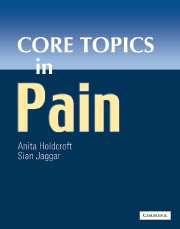Book contents
- Frontmatter
- Contents
- Contributors
- Preface
- Acknowledgements
- Foreword
- General abbreviations
- Basic science abbreviations
- PART 1 BASIC SCIENCE
- PART 2 PAIN ASSESSMENT
- Section 2a Pain measurement
- Section 2b Diagnostic strategies
- PART 3 PAIN IN THE CLINICAL SETTING
- Section 3a Clinical presentations
- Section 3b Pain syndromes
- PART 4 THE ROLE OF EVIDENCE IN PAIN MANAGEMENT
- PART 5 TREATMENT OF PAIN
- Section 5a General Principles
- Section 5b Physical treatments
- Section 5c Pharmacology
- Section 5d Psychosocial
- 44 Psychological management of chronic pain
- 45 Psychiatric disorders and pain
- 46 Chronic pain and addiction
- 47 The role of the family in children's pain
- 48 Palliative care
- PART 6 SUMMARIES
- Glossary
- Index
44 - Psychological management of chronic pain
from Section 5d - Psychosocial
Published online by Cambridge University Press: 10 December 2009
- Frontmatter
- Contents
- Contributors
- Preface
- Acknowledgements
- Foreword
- General abbreviations
- Basic science abbreviations
- PART 1 BASIC SCIENCE
- PART 2 PAIN ASSESSMENT
- Section 2a Pain measurement
- Section 2b Diagnostic strategies
- PART 3 PAIN IN THE CLINICAL SETTING
- Section 3a Clinical presentations
- Section 3b Pain syndromes
- PART 4 THE ROLE OF EVIDENCE IN PAIN MANAGEMENT
- PART 5 TREATMENT OF PAIN
- Section 5a General Principles
- Section 5b Physical treatments
- Section 5c Pharmacology
- Section 5d Psychosocial
- 44 Psychological management of chronic pain
- 45 Psychiatric disorders and pain
- 46 Chronic pain and addiction
- 47 The role of the family in children's pain
- 48 Palliative care
- PART 6 SUMMARIES
- Glossary
- Index
Summary
Introduction
It is axiomatic to state that patients experiencing chronic pain often experience significant psychological dysfunction. Any clinician who has spent any time in a pain clinic will be aware of the high levels of emotional and behavioural disturbance that can occur in this patient group. Depression, anxiety and anger are common emotional states associated with chronic pain. Moreover, pain patients may show unusual gait patterns, with guarding and bracing of affected areas of the body, and other physical behaviours. The psychological perspective from which one addresses these difficulties depends very much upon the model of pain, implicit or explicit, that one holds. The first section of this chapter will therefore discuss pain models and their relationship to treatment. Key psychological theories will then be laid out (as they apply to chronic pain) and the various components of the theories discussed. Finally, a number of relevant issues in the application of psychological treatments for chronic pain will be discussed.
Chronic pain and psychology: separation or integration?
The publication of the gate control theory of pain in 1965 marked a shift in thinking, in relation to psychological processes in pain. Up to that point, the experience of pain was largely a biomedical phenomenon. How much you were hurt was dependent upon where you were injured, and the extent to which your tissues were damaged.
- Type
- Chapter
- Information
- Core Topics in Pain , pp. 293 - 298Publisher: Cambridge University PressPrint publication year: 2005



